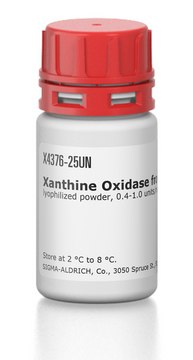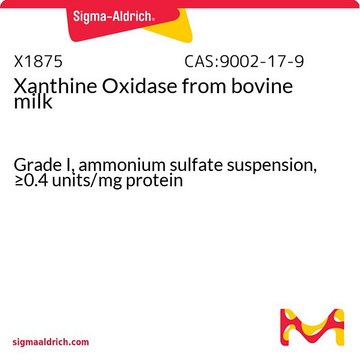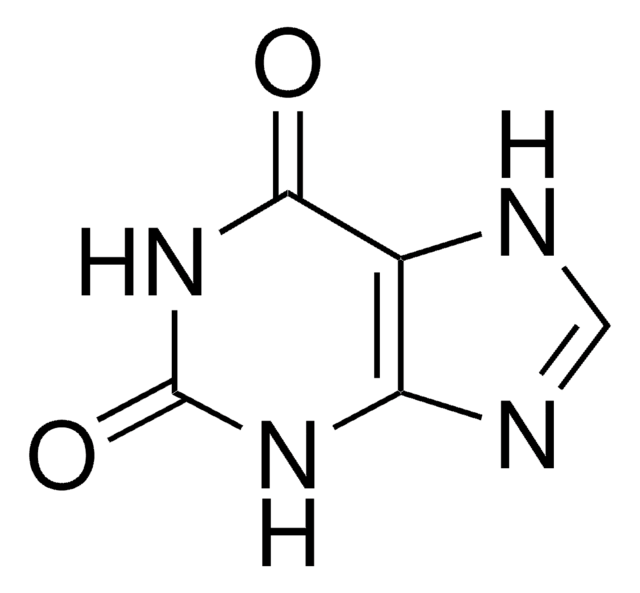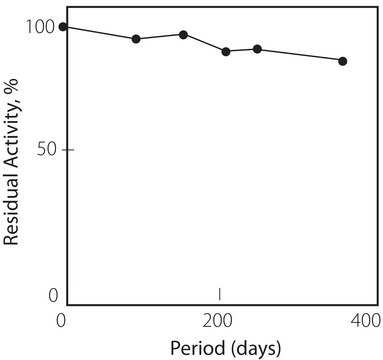MAK186
Xanthine/Hypoxanthine Assay Kit
Sufficient for 100 Colorimetric or Fluorometric tests
Synonym(s):
Xanthine and Hypoxanthine Detection Kit
Sign Into View Organizational & Contract Pricing
All Photos(2)
About This Item
Recommended Products
detection method
colorimetric
fluorometric
relevant disease(s)
neurological disorders; rheumatological diseases
storage temp.
−20°C
General description
Xanthine is a purine base present in body fluids, tissues, and plants cells. It is also found in urinary calculi. Xanthine is formed by the oxidation of hypoxanthine during the degradation of adenosine monophosphate (AMP) to uric acid. Xanthine/ hypoxanthine measurements in plasma and urine have been used to monitor allopurinol therapy. Cerebrospinal fluid (CSF) xanthine/hypoxanthine levels have been used as therapeutic guides and disease progression markers in hydrocephalus.
The Xanthine/Hypoxanthine Assay Kit is a highly sensitive assay for determining xanthine/hypoxanthine levels (ranging from 4-20 nmole/well for the colorimetric assay and 40-200 pmole/well for the fluorometric assay) in a variety of biological samples. Xanthine/hypoxanthine concentration is determined by an enzymatic assay, which results in a colorimetric (570 nm) or fluorometric (λex = 535/λem = 587 nm) product, proportional to the xanthine/hypoxanthine present.
Note: The fluorometric assay is ~10 times more sensitive than the colorimetric assay.
The Xanthine/Hypoxanthine Assay Kit is a highly sensitive assay for determining xanthine/hypoxanthine levels (ranging from 4-20 nmole/well for the colorimetric assay and 40-200 pmole/well for the fluorometric assay) in a variety of biological samples. Xanthine/hypoxanthine concentration is determined by an enzymatic assay, which results in a colorimetric (570 nm) or fluorometric (λex = 535/λem = 587 nm) product, proportional to the xanthine/hypoxanthine present.
Note: The fluorometric assay is ~10 times more sensitive than the colorimetric assay.
Features and Benefits
Compatible with high-throughput liquid handling systems.
Suitability
Suitable for the detection of Xanthine/Hypoxanthine in a variety of samples such as tissue, cells, and body fluids.
Principle
The Xanthine/Hypoxanthine Assay Kit is a highly sensitive assay for determining xanthine/hypoxanthine levels (ranging from 4-20 nmole/well for the colorimetric assay and 40-200 pmole/well for the fluorometric assay) in a variety of biological samples. Xanthine/hypoxanthine concentration is determined by an enzymatic assay, which results in a colorimetric (570 nm) or fluorometric (λex = 535/λem = 587 nm) product, proportional to the xanthine/hypoxanthine present.
Other Notes
The fluorometric assay is ~10 times more sensitive than the colorimetric assay.
Kit Components Only
Product No.
Description
- Xanthine Assay Buffer
- Peroxidase Substrate
- Xanthine Enzyme Mix
- Developer
- Xanthine Standard
Signal Word
Danger
Hazard Statements
Precautionary Statements
Hazard Classifications
Aquatic Chronic 3 - Resp. Sens. 1 - Skin Sens. 1
Storage Class Code
10 - Combustible liquids
Regulatory Information
动植物源性产品
Choose from one of the most recent versions:
Certificates of Analysis (COA)
Lot/Batch Number
Don't see the Right Version?
If you require a particular version, you can look up a specific certificate by the Lot or Batch number.
Already Own This Product?
Find documentation for the products that you have recently purchased in the Document Library.
Konstantinos Feidantsis et al.
Journal of comparative physiology. B, Biochemical, systemic, and environmental physiology, 190(4), 403-418 (2020-04-27)
For a comprehensive understanding of fish responses to increasing thermal stress in marine environments, we investigated tissue energetics, antioxidant levels, inflammatory and cell death responses in Sparus aurata (gilthead seabream) red muscle during exposure to elevated temperatures (24 °C, 26 °C, 30 °C)
Our team of scientists has experience in all areas of research including Life Science, Material Science, Chemical Synthesis, Chromatography, Analytical and many others.
Contact Technical Service





